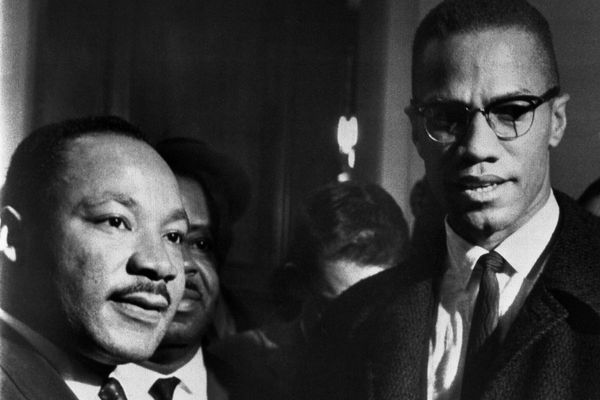
In the struggle for racial equality in America, two names stand out more than most: Malcolm X and Martin Luther King Jr. Both men became iconic figures in the Civil Rights Movement, but they stood on opposite ends of the ideological spectrum. Although they shared a deep passion for justice and liberation, their methods, beliefs, and backgrounds were sharply different.
Their only meeting—brief and unscheduled—took place on March 26, 1964, at the U.S. Capitol. They exchanged only a few words and a handshake, but that moment symbolized two different approaches converging, if only for a moment.
Here are some of the main differences between MLK and Malcolm X—differences that shaped the Civil Rights Movement and continue to influence conversations about activism and racial justice today.
1. Approach to Civil Rights Activism
Perhaps the most famous contrast between the two leaders is their approach to fighting racial oppression.
- Dr. Martin Luther King Jr. believed in nonviolent resistance. Inspired by Mahatma Gandhi, he preached peaceful protests, civil disobedience, and love in the face of hate. His dream was one of integration—Black and white Americans living side by side in equality.
- Malcolm X, on the other hand, initially advocated for Black nationalism, self-defense, and separation. He famously declared that African Americans should gain freedom “by any means necessary,” including armed resistance if needed.
These opposing methods defined their public personas—King as the peacemaker, Malcolm as the firebrand.
2. Religious Beliefs and Institutions
Both men were ministers, but their religious frameworks were vastly different, shaping their philosophies and rhetoric.
- Dr. King was a Christian Baptist preacher, rooted in the traditions of the Black church. His sermons and speeches often quoted the Bible and emphasized love, forgiveness, and turning the other cheek.
- Malcolm X was a Muslim minister with the Nation of Islam before breaking away and embracing Sunni Islam. His earlier teachings were influenced by Elijah Muhammad and framed white Americans as historical oppressors who could not be trusted.
These differing spiritual influences informed how each man viewed America, its history, and the path to liberation.
3. Views on Integration vs. Separation
The two men diverged sharply on the issue of racial integration.
- King believed that the future of America was a multiracial democracy. He wanted Black and white children to attend the same schools, live in the same neighborhoods, and share in the American dream.
- Malcolm X, during his Nation of Islam years, saw integration as a trap. He believed Black people needed to separate from white society to build their own institutions and reclaim their cultural identity.
Even after leaving the Nation of Islam, Malcolm remained skeptical of full integration, advocating instead for Black self-determination.
4. Attitudes toward White Allies
King and Malcolm X had different opinions on working with white people in the fight for equality.
- Dr. King welcomed the involvement of white allies in the Civil Rights Movement. He marched alongside white clergy, students, and activists, believing that change required coalition-building across racial lines.
- Malcolm X, especially early on, was deeply distrustful of white allies. He warned Black people not to rely on white support, emphasizing that liberation must come from within the Black community.
Later in life, Malcolm X softened some of his views and began to see possibilities for global solidarity, including alliances beyond race—but still with caution.
5. Background and Education
Their personal backgrounds and paths to leadership were also different.
- King was born into a middle-class family in Atlanta, Georgia, with access to education and the Black church’s leadership. He earned a Ph.D. in systematic theology and became a national figure through intellectual and moral leadership.
- Malcolm X came from a working-class background marked by trauma. His father was killed when he was young, and his mother was institutionalized. He dropped out of school in the eighth grade, spent time in prison, and educated himself through reading and reflection while incarcerated.
These contrasting life journeys gave each man a unique lens through which he saw the world and the struggle for Black liberation.
6. Legacy in the Eyes of the Public
Even in death, the two leaders have been remembered differently by the broader American public.
- Martin Luther King Jr. became a national hero—with a federal holiday, monuments, and school curricula celebrating his dream of peace and unity. His message was more palatable to mainstream America, especially after his assassination.
- Malcolm X was often portrayed as controversial and militant in life and death. It took years for his legacy to be fully appreciated. Today, however, he is revered for his honesty, courage, and insistence on Black dignity and pride.
Both men are now recognized as essential figures, but their public image and reception have followed different trajectories.
Although their philosophies clashed, Malcolm X and Martin Luther King Jr. were not enemies—they were products of different experiences, addressing a shared pain in distinct ways. Understanding the differences between them is essential, not to divide, but to recognize the complexity of the Civil Rights Movement.
Just as their similarities offer unity, their differences offer a fuller, richer picture of what the fight for justice really looked like—and still looks like today.
